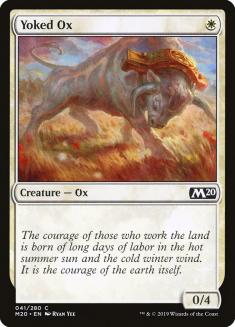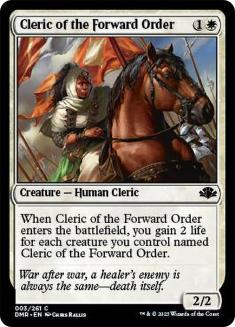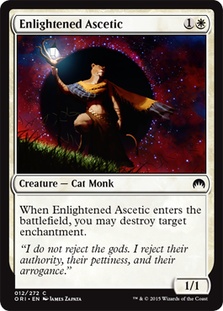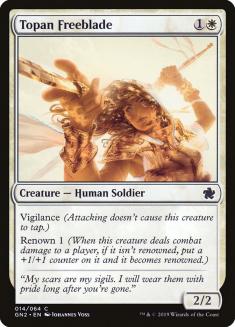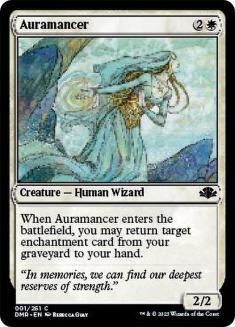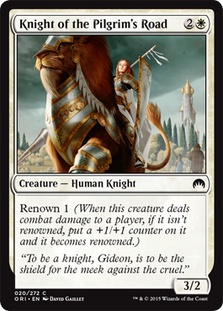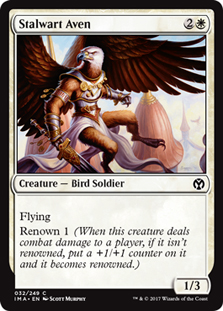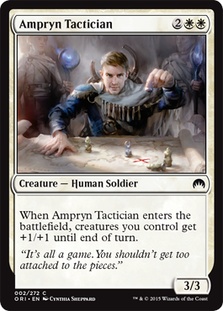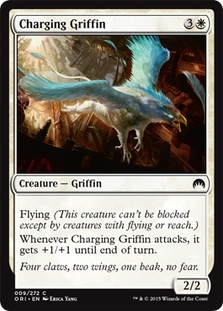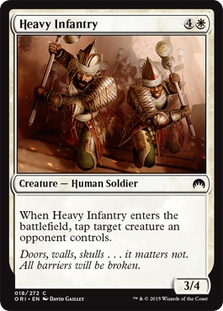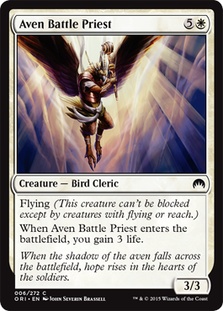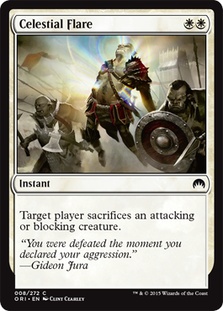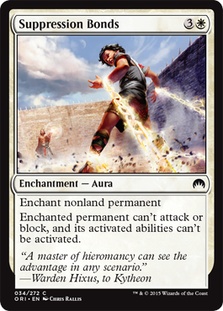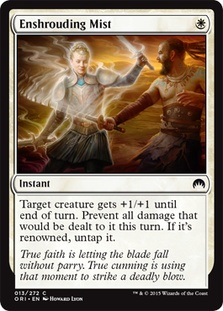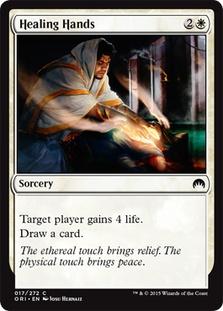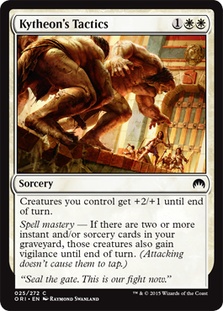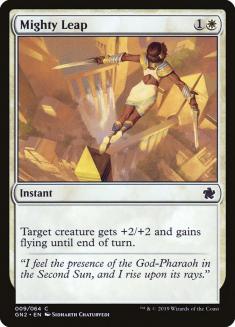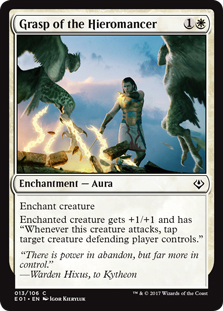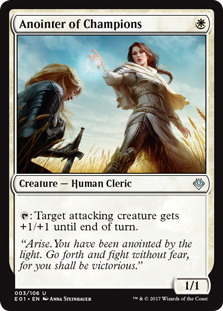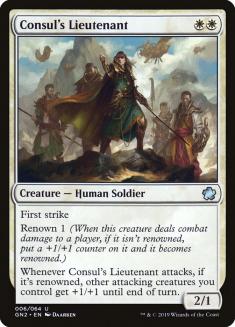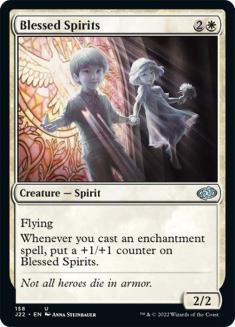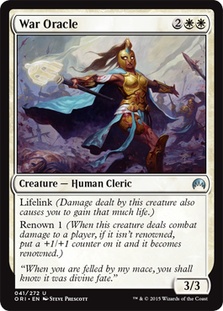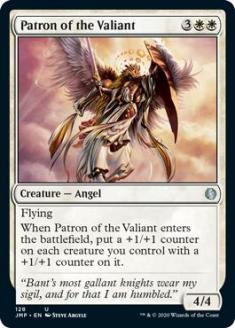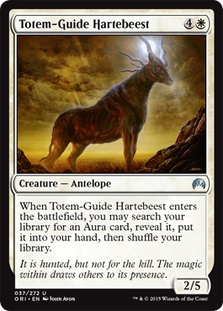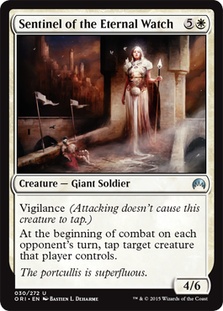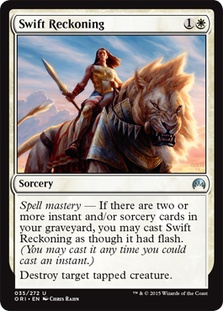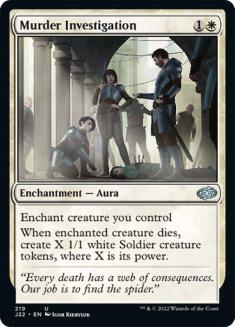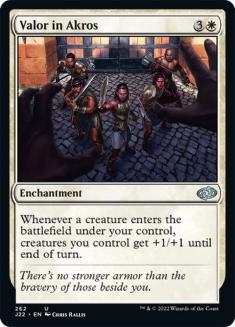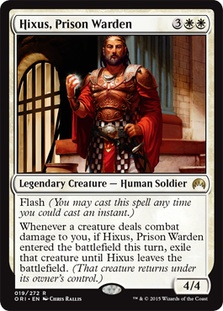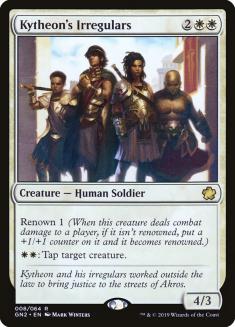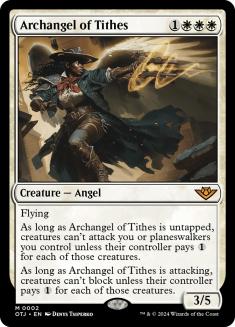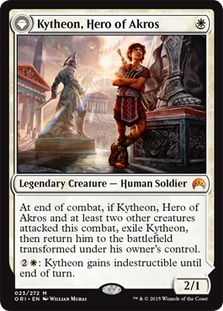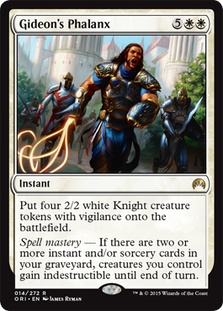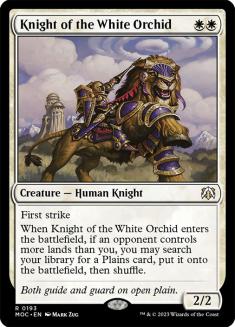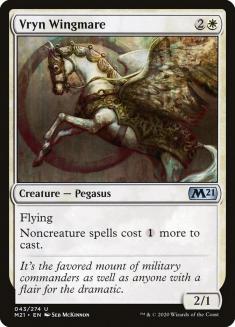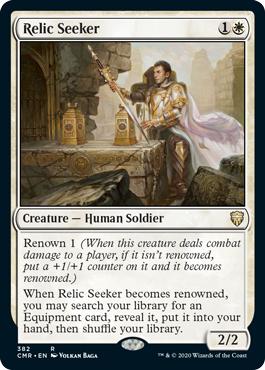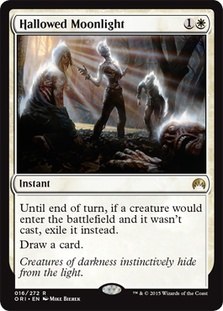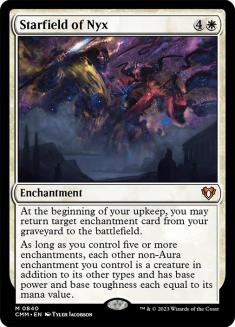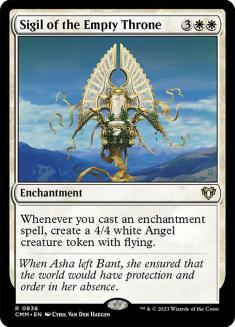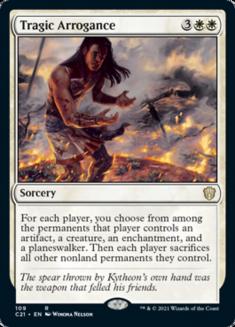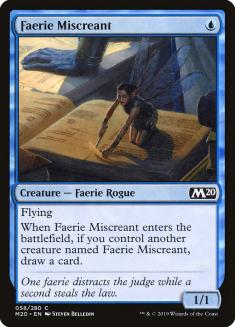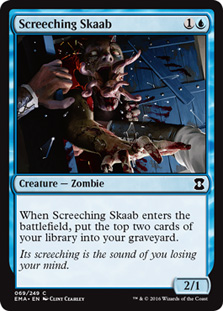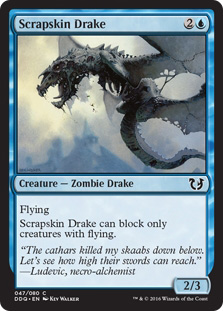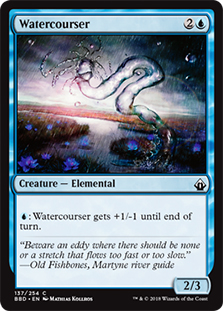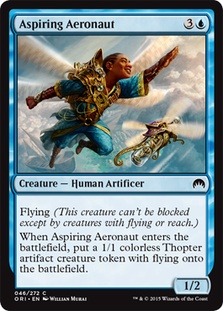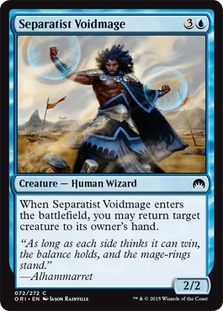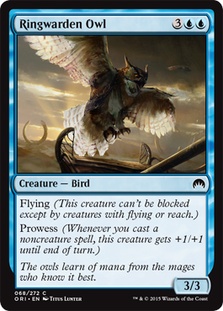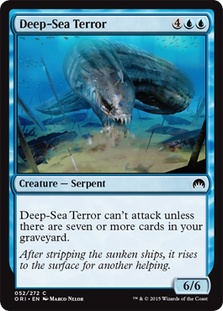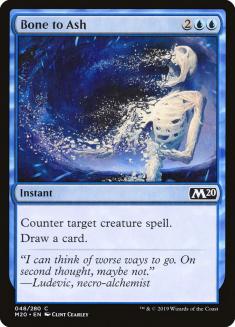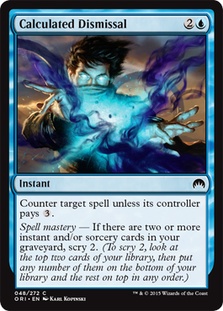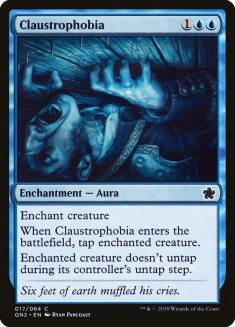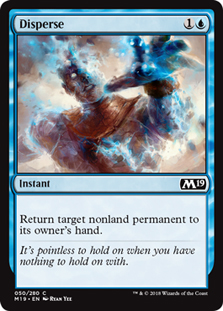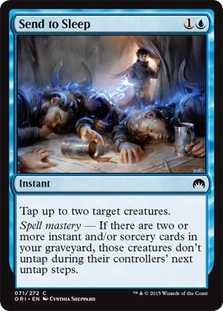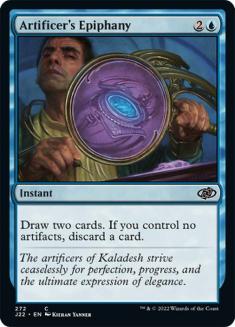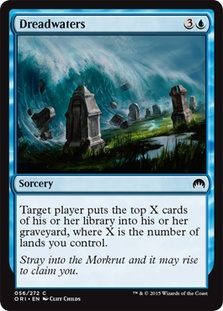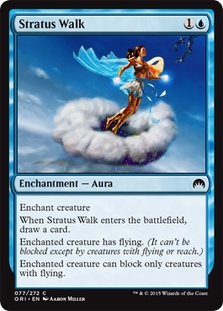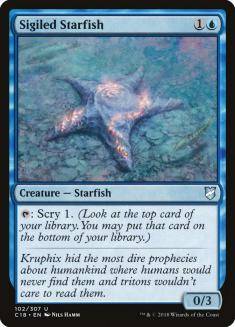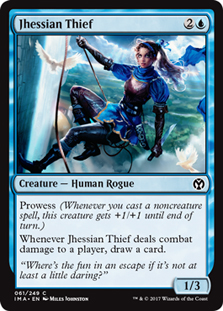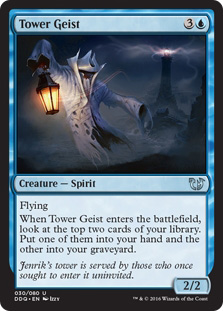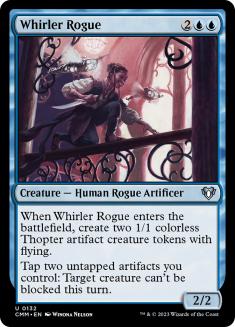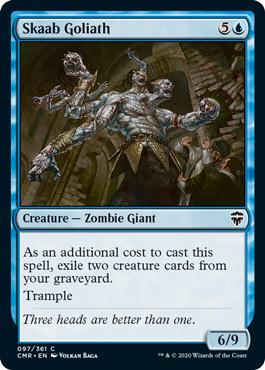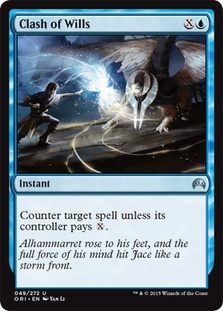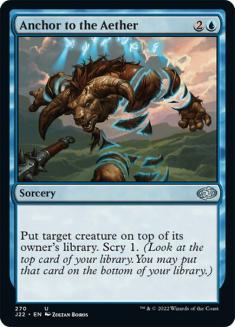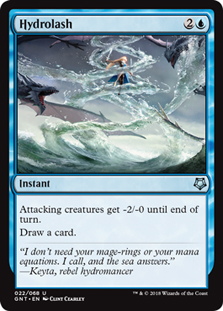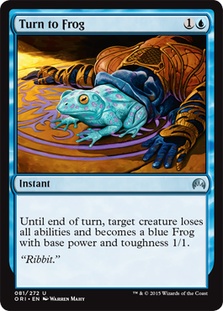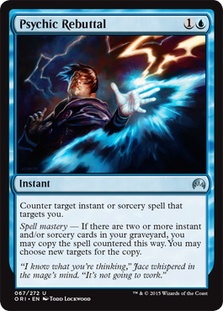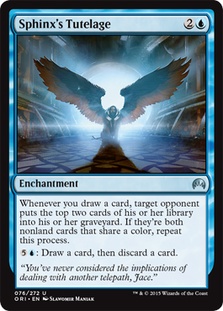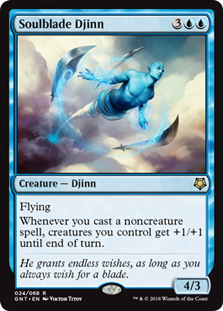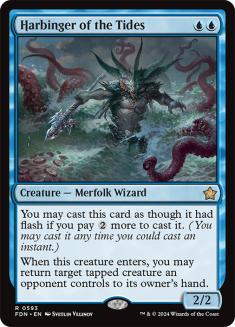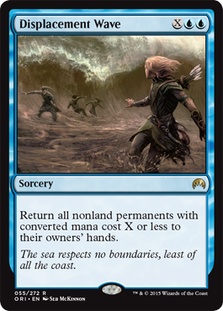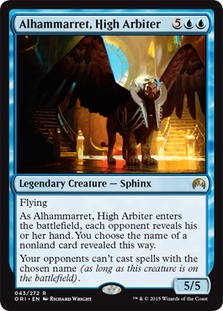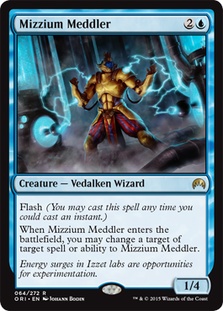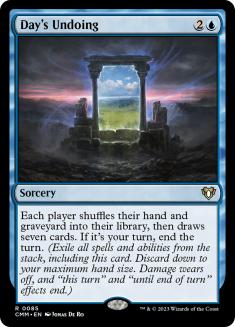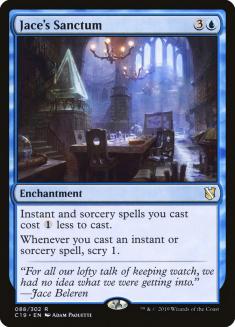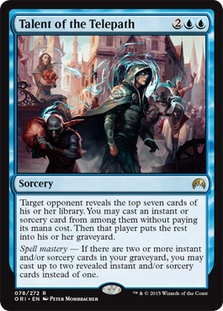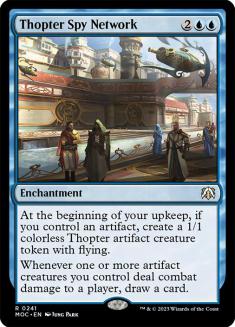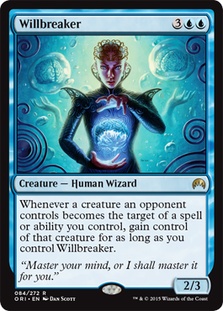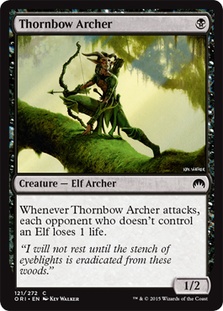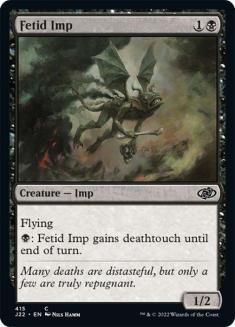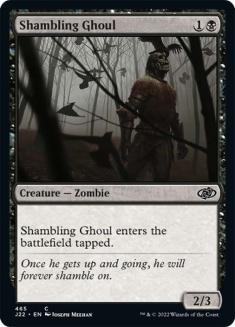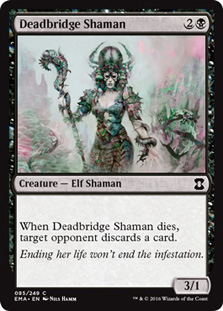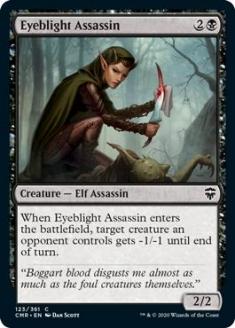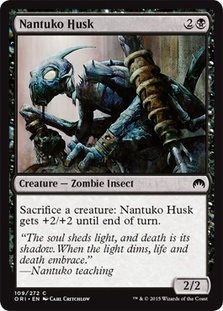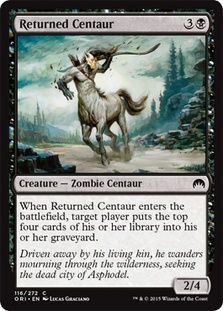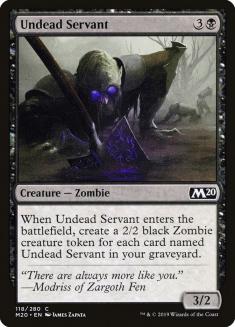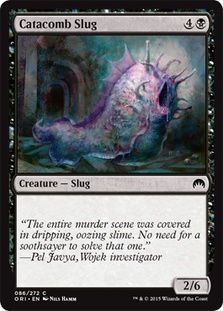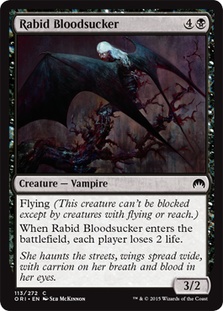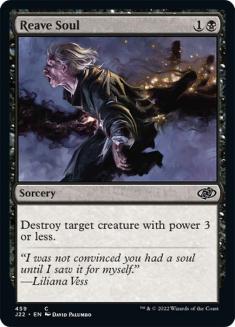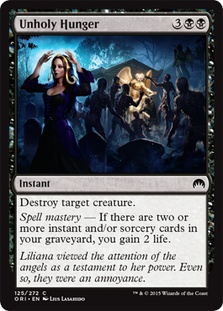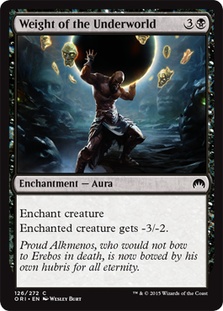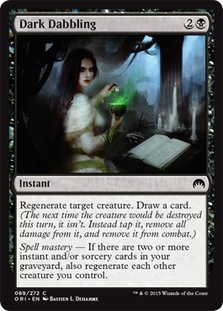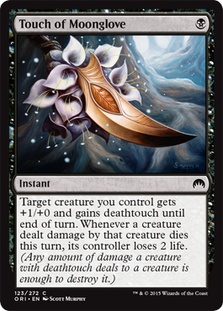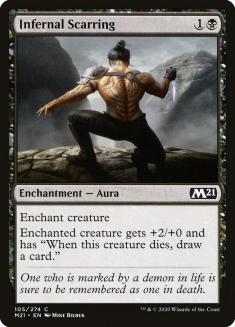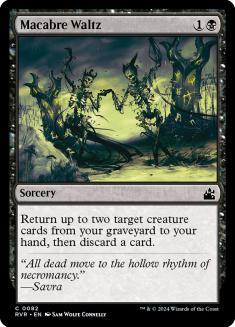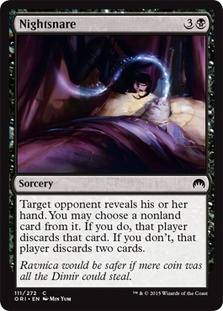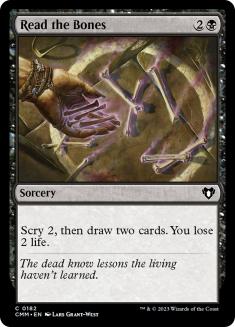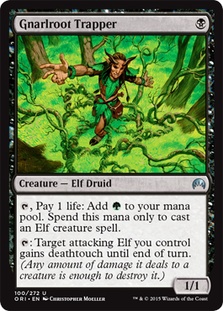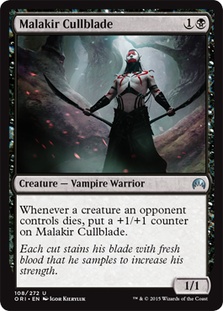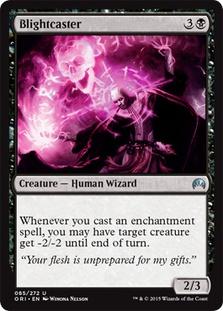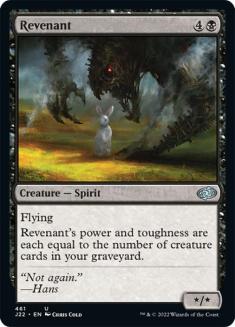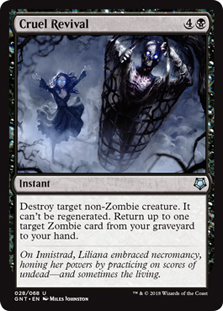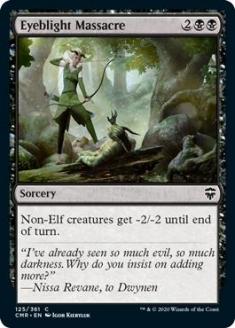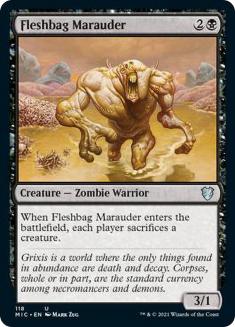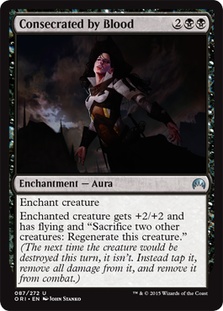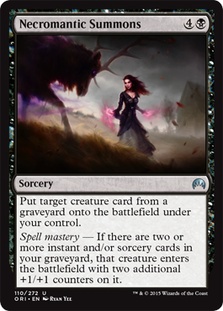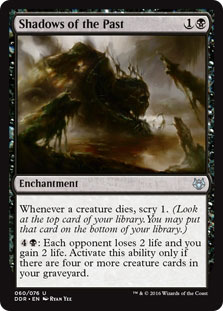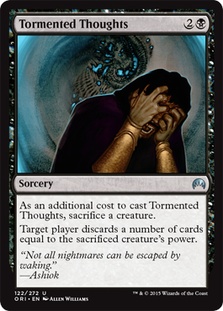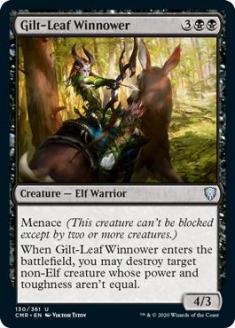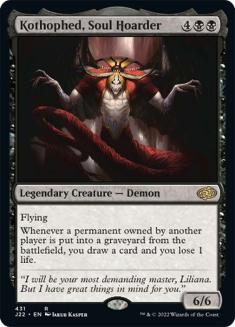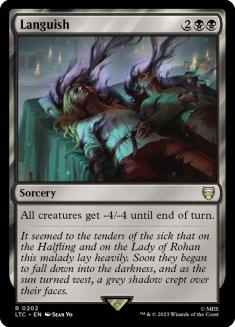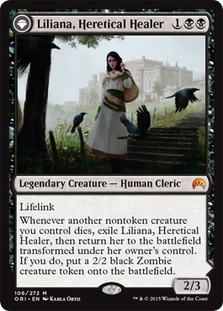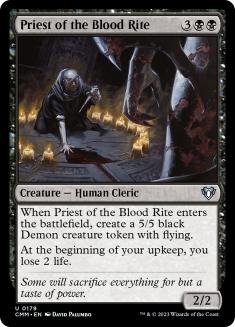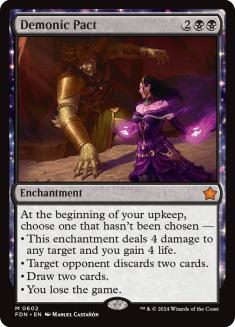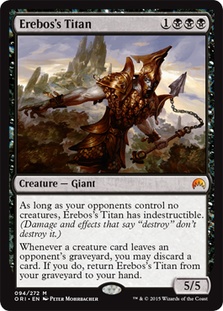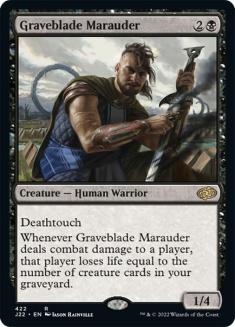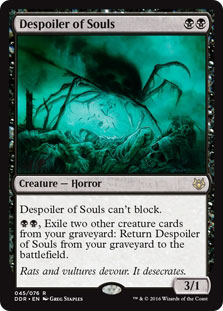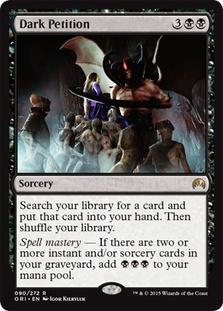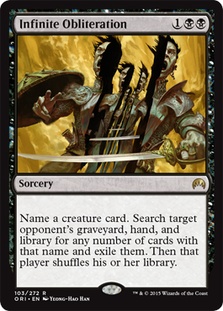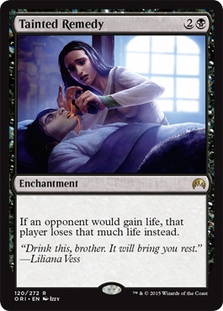Core Set Limited was a long-running joke until Magic 2010 revitalized what it meant to be a Core Set. Since then the Limited experience of these sets has constantly improved, except for the notable nosedive that was Magic 2014.
Magic Origins appears to continue and close out this trend. What you have with this set is clearly a tightly-developed product with a lot of places to work with small positive interactions inside a clearly-defined set of base format rules.
White
Common Creature By Curve
One Mana:
Two Mana:
Three Mana:
Four Mana:
Five Mana:
Six Mana:
Removal
Tricks
Other
It feels like a lot of how good white is has to do with how big of a jump 3/3 is from 2/2. Looking at the other colors and the general sizing of the format, it seems like the answer is very. Once you hit five mana you start seeing commons that brick a 3/3, but at lower costs you are mostly trading or bouncing when creatures fight in combat. Also worth noting: beyond Renown this makes Ampyrn Tactitian’s trigger quite relevant.
Yoked Ox has very minimal positive interactions with the other white cards. Everything else with the exception of Aven Battle Priest is a very proactive card. They play well from ahead, Ox plays to make your opponent hold back and stall the board. For the most part consider this a sideboard option for mirrors, with the exception of it potentially being strong if you end up with some control deck.
On the note of a control deck and Aven Battle Priest, a common Angel of Mercy seems real nice. My guess is this is a card most decks are cool ending up with a copy of just to have something at the high end if they don’t have a better rare or uncommon, but in B/W it seems like the best common finisher you can have. Yes, black is definitely the better control color than blue. I’ll get to it later but a lot of this is based on Read the Bones and Macabre Waltz being better card advantage/filtering spells than the blue options.
Suppression Bonds is expensive, but there are only a couple other commons that can kill an X/4. Two of the four are enchantments, so in turn your W/G deck definitely wants access to sideboard Enlightened Ascetic or a similar effect to clear out most of the answers for your 4/4s.
On the above note, nothing under five mana tangles with a Renowned Stalwart Aven. There’s also a general shortage of non-Thopter fliers, so I expect this card does some good work. Just being a 1/3 to stop the artifact chip shots is probably good, and when it gets to a 2/4 it’s relevant on both offense and defense. It’s also basically the only creature in the color that is about as good from behind on board as it is from ahead (Aven Battle Priest costing six means you have to be “ahead” in the sense of not dying before you cast it).
Celestial Flare is more important in that it should be played around than anything else. Remember that you can cast this card after damage has been dealt while still in combat. Example: Your opponent attacks with a 2/2 and a 4/4 into your 2/2. If you trade 2/2s, the 4/4 is still attacking in combat after damage has been done, ready to be Flared.
Based on experiences with Modern Masters 2015 draft, Mighty Leap is very similar to a Lava Axe that you can play around. If it’s going to kill you, I would advise making sure it not do so.
If the format is aggressive I’m always a big fan of one mana tricks, and Enshrouding Mists is definitely a good one. Stops the Green and Red removal, both levels up your creature in combat relevantly (again 2/2 => 3/3 is great) and ensures you win it, and in races upgrades to a pseudo-Neck Snap by untapping a Renowned blocker. Not a card you want a huge number of as it’s still conditional, but its high end is real high in terms of tempo returns and it is fairly broad.
Grasp of the Hieromancer feels real similar to Glaring Aegis, which has definitely proven to be solid. Slightly less of a body is left around, but the effect repeats and the immediate impact of connecting is bigger due to Renown. Auras have disadvantages, but they aren’t necessarily designed to be bad anymore.
Brief look at color combinations: B/W gets to make Auramancer and Cleric of the Forward Order better due to Weight of the Underworld and recouping Read the Bones life respectively. R/W can sometimes make Kytheon’s Tactics better due to Dragon Fodder and Thopters, but more realistically it makes the many tap effects and Mighty Leap better due to Cobblebrute and Prickleboar. G/W feels oddly disjointed as green is a card advantage and fatties color to white’s tempo and beaters, most likely is a base-white deck that has some of the great green cards and not a lot of filler. U/W is a lot about the mass pump effects with dorky fliers and a Mist Raven effect to maximize your attackers to blockers differential.
Uncommon Creatures By Curve
One Mana:
Two Mana:
Three Mana:
Four Mana:
Five Mana:
Six Mana:
Removal
Other
Beyond this, basically all of the other white uncommon creatures are above par. I might even be underrating Sentinel of the Eternal Watch here, aka massive body plus the “bad” half of Palace Siege. There’s literally one common that kills it by taking it off the board.
Knightly Valor was excellent at common in Return to Ravnica. The fact that it has been bumped up a rarity should really tell you how insane it is here.
Swift Reckoning is a two-mana Assassinate that goes full on Rebuke later. This may not seem great as both of those cards are historically average, but A) there’s a lot of tap effects in the format to set it up and B) the removal for large things is scarce in this format.
Totem-Guide Hartebeast seems clutch in the various control decks as it’s just a giant blocker that tutors up a removal spell. The fact that this, Aven Battle Priest, and Suppression Bonds are all just one white makes me feel like a base U/B Esper control draft is something that is draftable if you highly prioritize Evolving Wilds.
Pretty sure Blessed Spirits is also better than it looks. Wind Drake/Wild Griffin is a fine size in a format where the most common flier is a 1/1 Thopter, the first trigger makes it great, and if you ever get a second one it’s pretty impossible to beat a 4/4 flier. On that note, why does Patron of the Valiant just get a bonus trigger when Air Elemental was more than enough to start with?
I have no idea how good Valor in Akros is. There’s probably some W/R deck where you have a million tokens and it is unbeatable, but in general… it’s likely mediocre is my guess. Inconsistent and slow are not the adjectives you want tacked onto your Glorious Anthem.
Rares
Great:
Good:
OK:
No Thanks:
Unknown:
This is the first time I’m completely reviewing rares in this series. While they aren’t the core of any Limited format, something I’ve learned from recent formats is that the rares can shape a lot of the directions drafts go. If a color is overly saturated with slam-dunk higher rarity cards it can often lead to fights over it early on, and if a mediocre color has a few great rares it’s also worth realizing what you are giving up in overall power level to take one.
I’ve come up with these general groupings to figure this out.
Great – First pick, first pack. Wins a game on its own fairly easily and regularly.
Good – Significantly above replacement value, but is missing something to make it great. Maybe it’s really strong but a bit too conditional on deck construction and board state, like Corpseweft from Dragons of Tarkir. Maybe it’s hard to cast and not quite insane enough to really warrant deforming your deck to play, like Triad of Fates from Theros. Maybe the card is just a really good rate but not a game-breaker, like Ivory Fortress from Khans of Tarkir. The range here on these cards is pretty high, but the general idea is that you may want to pick these cards highly but passing them is not unthinkable and may depend on your deck. These are the cards that when you say “Is this better than the best uncommon” and you have to pause and think about it. Some of them might be just a bit better depending on where the line is set. For the record, I think that line in this set is Cruel Revival or Whirler Rogue, though it is possible some giant flier or similar is better.
OK – It’s playable. Not exciting, maybe not even for every deck, but it has an effect. A perfect example from Dragons of Tarkir is Obscuring Aether. This category will also include cards that are generally not great but in the right deck have a home as a reasonable card, like Villainous Wealth or Rakshasa Vizer in Khans of Tarkir.
No Thanks – Not a card for Limited. The ole Daybreak Coronet in Modern Masters 2015 with only one common enchantment to go with it.
Unknown – Some cards you just have to play with. Could be a brick, could even be great. Again, see Corpseweft.
Moving on to the cards in question:
Hixus and Kytheon’s Irregulars should be no-brainer slam dunks. Hixus is a large flash body that can Wrath your opponent, and Kytheon’s Irregulars is an oversized creature that can dominate a board all by itself.
Archangel of Tithes is really great if cast, but triple-white is a real restriction. Probably still fine to slam this first pick most of the time, but be aware that it gets a decent amount worse if your main color isn’t white.
Kytheon is powerful, but he loses value fast and doesn’t necessarily dominate a game without help. On-curve he’s probably borderline unbeatable, on turn seven he’s just a card.
Knight of the White Orchid is a lot better in B/W than anywhere else as you are more likely to really want the extra land to hit your fives and sixes after taking control. Another way to look at it: B/W is the deck most likely to want to play this after turn three.
Gideon’s Phalanx is the only other OK card worth discussing. Similar to Knight of the White Orchid, it’s best in B/W where some silly expensive card is fine. I’m reminded a lot of Revel of the Fallen God here, which won a lot of games where it was cast but sometimes was just not super impressive. A seven-drop that can be bricked by a couple of 3/3s is not going to always be great, and if your opponent knows about it, the indestructable Wrath mode of it is not happening.
I think you need to trigger Sigil of the Empty Throne twice for it to be good, but the first trigger buys a lot of time for the second. This is probably one of those cards that 90% of the time you look at four other enchantments and realize it isn’t really enough, but that other 10% you have enough to make it worth debating whether you want to play it. Again, basically a B/W card, and even then I’m not sure if the number of enchantments is there or if you really want to play aggressive enchantments to support this. Maybe there’s a B/W aggro sub-archetype that really wants the Grasp of the Hieromancers and Infernal Scarrings that are going around, or maybe this is just a “Oh look, I have two so I can go buck wild” once-in-a-blue-moon rare.
Tragic Arrogance is super situational. Your best creature has to be way better than their worst. It’s also fairly reasonable to play around if you know it is coming. I expect this to be a card that moves between maindeck and sideboard a lot, and unlike the comparably swappable Illusory Gains in Dragons of Tarkir I don’t think the default mode of this card is so powerful it makes it a high pick. Gets better in W/U where you can choose to leave them with a Claustrophobia’ed or Suppression Bond’ed creature, probably also better in W/G as your one creature is approximately a 1000/1000 compared to the rest of the format.
Blue
Common Creatures By Curve
One Mana:
Two Mana:
Three Mana:
Four Mana:
Five Mana:
Six Mana:
Removal
Tricks
Other
This feels like a format where blue is really punished for being creature-light due to the cascading nature of Renown. While the color does have the best common removal spell, the rest of the cards feel really mediocre. There isn’t a lot in the color to really stabilize you, so again we have a color that plays best from ahead.
Scrapskin Drake seems like a real easy way to die. Great if your deck is aggressive, pretty bad if it isn’t.
Aspiring Aeronaut is really inefficient when it isn’t the theme of your deck to get the board all dorky. Basically a U/W card, even though red is the other artifact color.
I think the line on Faerie Miscreants going from bad to good is five. If you have more than five, it has to be great as it’s really easy to pseudo-Spectral Procession. If you have less than five, getting multiples into play is hard.
Separatist Voidmage is A) good, B) splashable, and C) the most likely card in the format to make you rage quit. This is the card that makes some of the most-unbeatable Renown draws, especially if you ever get multiples.
Ringwarden Owl might also be a high pick, but I’m really unexcited about blue so I’m valuing it lower. It is an “Air Elemental” at common, except that the turn it lands it is just a 3/3 which doesn’t save you when you are dying in this format the same way a x/4 does. Also, note that this is the second of the best three blue commons that are double-blue when the rest of the color isn’t too deep.
Watercourser might actually be a top-five blue common, which is kind of sad. It does trade up and clock well if unopposed, but at the same time… it’s just Watercourser.
I’m having a hard time finding the cards I want to cast if my opponent doesn’t run a creature into my Bone to Ash. The card is still good against slower decks and still a raw two-for-one answer, but it’s something that is very easy for your opponent to sniff out and not walk into at little cost. Same applies to Calculated Dismissal.
So, in terms of Send to Sleep, how often do you have active Spell Mastery in Limited? The average Limited deck is around fifteen creatures, eight spells and seventeen lands. Even if all of those spells are instants and sorceries, that’s around seven or eight turns of play before you are expected to see three total. I think that puts Send to Sleep a little out of range of being good, as having Spell Mastery earlier while applying pressure is hard and if you don’t get it until later, the card has very diminishing returns. If tap two creatures alone is good enough this will be fine, but that doesn’t seem likely. Disperse is likely much better as it actually helps you come back from behind by resetting Renown.
I’m actually pretty excited about Stratus Walk in multiple decks. The Renown thing is obvious, but I’m pretty sure the Cobblebrute one is better.
Color combos: As per above, U/W is really pushing and aggressive tempo deck as far as it can go and wants the fliers and bounce. U/R is your classic steal the game with a flying 5/2 lump of bricks deck and really wants a lot of the tricky cards like Stratus Walk. Maritime Guard is also better there as you need some breathing room to set up your shenanigans. U/G again feels disjointed, but moreso because you want to be base-green “splashing” the double-blue cards. U/B is your classic two for one deck, though being in blue there is basically you saying that white isn’t open and you are willing to play slightly-worse versions of all the same cards to have a deck.
Note that some of this blue hate is likely a bit over exaggerated. Blue is historically a color that overperforms compared to how its cards look on paper just due to options being powerful. There’s just a consistent issue where the best cards cost double-blue but the filler cards don’t justify basing a deck in the color.
Uncommon Creatures By Curve
Two Mana:
Three Mana:
Four Mana:
Six Mana:
Removal
Tricks
Other
Similar to Knightly Valor, Sigiled Starfish was excellent at common in its original format and is now an uncommon. Should be a hint that it’s even better here with more 2/2s to block.
Tower Geist is as close to Mulldrifter as we are going to get. Take your two-for-one flier and don’t complain. Also, it’s splashable.
Whirler Rogue is basically the definition of a trap card. You get Cloudgoat Ranger but the rest of the color is unexciting and it’s double-blue to cast. If you take this first pick, don’t be afraid to abandon ship.
Turn to Frog does not work how you want it to against +1/+1 counters.
I keep going back and forth on where to classify Time Ebb or Griptide effects. I think the answer is that they are tricks as the goal of removal is to permanently answer some crazy bomb, but they are pretty good ones. Anchor to the Aether is one of the better version of this effect, though I think it remains to be seen if this format is too fast to want what is effectively a three-mana tempo effect. Griptide in Theros was so great because you could easily double up on how much mana your opponent had to spend compared to your four by topping a Monstrous or Bestowed creature, but normally it’s a lot harder to make up the difference. If you are ahead and can do something with the “Time Walk” it’s obviously good, but there’s only so many good-while-ahead effects one deck can play.
Skaab Goliath is the biggest non-rare creature in the format and probably pretty good in any blue archetype except U/G where you are leaning on your six-drop to trump a clogged board. Also splashable. Evolving Wilds being the only common fixer is going to put a real premium on it.
Sphinx’s Tutelage math time! You are around 15% to 20% to hit another trigger on each flip depending on your opponent’s deck, so this mills an average of 2.35-2.5 cards per trigger. Assuming this lands on turn three when your opponent has 30 cards in deck after drawing before your first trigger, that’s around a nine-turn clock, or similar to a Phantom Warrior. I don’t actually think the card is the worst, but there are likely better win conditions you can find. The exception is if you deck is all crappy creatures, card draw, and no recursion and you would rather your opponent not be able to line any typical removal spell up with your finisher.
Rares
Great:
Good:
OK:
No Thanks:
Unknown:
As expected, a lot of Unknowns in blue. Also a lot of bad ones. Blue is definitely one of the colors where Wizards tends to slot in real odd rares that do something unique, in large part because something that is just big and has a good rate isn’t really that heavily in blue’s color pie.
Disciple of the Ring seems really good. I don’t expect it to get more than two or three activations most games, but a 3/4 is a fine body in this format and it seems reasonable to be able to leverage a small number of activations to a pretty big end effect here given all of the options. If they block, you pump it and make the block bad. If they don’t block and try to swing back, you untap it and block. If they do nothing, you are slowing winning. Even in a case where it is brickwalled, you have the eventual threat of tapping everything.
Jace, Vyrn’s Prodigy is really good if you have removal to flashback with it. In U/B or U/R, you really want this card, in U/W or U/G. it’s a lot more average.
Displacement Wave is on the higher end of OK. It seems that the best use of the card is as a Falter. Similar to why Day’s Undoing is bad, if your opponent has the first shot at redeploying they are going to win. U/G likely loves this card, and I don’t think U/R is far behind. It’s also distinctly better against white decks, where it also resets Renown. The fact that it is super conditional caps the default power level, but in some decks it will be insane. Just don’t forget that you don’t want to combine this and Thopters.
Mizzum Meddler is a fairly expensive trick to leave up. My only comment on the card is that you really should not forget that this is just going to have to be a Horned Turtle a lot.
Alhammaret, High Arbiter is a little better than it looks on the surface. It’s a seven-mana 5/5 flier, but your opponent can’t sandbag removal for it. Seven is a lot of mana, but forcing them to rip a kill spell is a reasonable bonus if you are going to invest in it.
The only note I have on the bricks is that Talent of the Telepath could be really good to sideboard in if you are playing the right matchup. This will maybe happen once every other time you have the card.
As for the Unknowns…
Thopter Spy Network seems absurd if it gets going, but my big concern is that it might just be too slow. If you already have Thopter tokens you are likely to have a stable board and get an immediate payoff, but if you don’t it’s a lot worse. You are setting up by playing an overcosted Artifact creature or a non-creature permanent, then spending a whole turn to cast this. Your first return on investment is a 1/1 the next turn. It’s very possible you are supposed to take this card early, but if you do you really need to be U/R and snatch up every Ghirapur Gearcrafter.
Willbreaker seems almost exclusively like a W/U or U/G card. Blue is shockingly bad at targeting creatures without removing them from play in this set, and white has multiple repeatable tapper effects. Green has less repeatable effects, but the interaction is much more welcome and there’s a lot of random things like Yeva’s Forcemage to get people with. There’s a number of black cards that do work with Willbreaker like Dark Dabbling, but at some point you realize they are all spells and you are deciding between playing those or hard removal.
Black
Common Creatures By Curve
One Mana:
Two Mana:
Three Mana:
Four Mana:
Five Mana:
Removal
Tricks
Other
Despite being light on real standout cards, the average power level in black is really high. This might be the color I’m most excited to draft in the set from a pure winning standpoint.
Black in this set appears to be all about attrition and exchanges. For a couple of the commons, this is bad news. I can easily see the life loss on Rabid Bloodsucker being a drawback, turning an already- expensive flier into something undesirable. Touch of Moonglove is not Coat with Venom and without the toughness pump is likely just -1 card to cast. Thornbow Archer is probably the hardest-hit card as even if you build an aggressive deck with black you are going to struggle to make it heavy enough black to want a one-drop.
On the flipside, a number of cards are a lot better than they look as a result of this. Dark Dabbling looks a lot like previous mediocre cards like Necrobite, but the text “draw a card” is huge, as it can actually generate a two-for-one and is never a purely dead draw. Returned Centaur was pretty bad the first time around, but it is a brick wall that generates an advantage here. Similarly, Catacomb Slug is also fine as the slightly bigger wall you can have a copy of to draw or board in against green. Note that both of these defensive creatures have two power.
Aside from the obvious Read the Bones, Macabre Waltz is what lets you leverage a lot of these exchange advantages in the long run. Again, it looks like another mediocre card like Tormenting Voice, except the two cards you “draw” are always spells. It’s even a castable card if you topdeck it while hellbent due to the strange ordering allowing you to return two creatures then discard one of them. None of these cards are excellent, but they are all solid role-players in the black deck.
Continuing the trend of being great while looking like an old card that was mediocre, Reave Soul is miles ahead of Defeat. In Dragons of Tarkir, Defeat just traded for an irrelevant small card like all the other small cards did. In this format, Reave Soul trades all the way up to five-drops and very importantly breaks up the exchange disparity set up by a Renown connect as very few Renown creatures jump further than 2/2 to 3/3.
I was just bemoaning the fact that Deadly Recluse is seen as too good, as it’s the green Doom Blade when I realized it wasn’t in the set, then I realized green’s Doom Blade was just colorshifted back where it belongs. Beyond being a virtual removal spell, Fetid Imp is really key here because one of the best ways other colors have to fight exchanges are the Thopter tokens it hold off.
There is a definite limit on how many copies of Weight of the Underworld and Unholy Hunger you can play without falling back on tempo as you try to react to each play with them. It’s possible with Unholy Hunger the limit is more than you can reasonably get in a draw, but with Weight of the Underworld it is likely much lower unless you are all-in on Auramancering them.
I’m still only really sideboarding Nightsnare in the same places I would previously sideboard discard (against bombs and other grindy decks), but I’m much happier as its one spell that always has the best mode for the situation.
Nantuko Husk isn’t super exciting in most decks, but I bet there is a B/U deck with Stratus Walk and Thopters or a B/R deck with Dragon Fodder and Subterranean Scout that makes it all work. Act of Treason is also common, so the usual combo still works.
I have a strong feeling Shambling Ghoul looks a lot better than it is. The tempo of a turn off blocking is punished a lot harder in a format where the 2/2 hitting you that turn is a 3/3 the next turn.
Eyeblight Assassin is also a lot worse. There aren’t a lot of x/1s to take out. Maindeck if necessary, sideboard if useful.
I’m torn on Infernal Scarring. On one hand no investment Auras are nice, but only pumping power means it is really easy for the pump to not matter when your creature trades off. Apply to fliers liberally, avoid in ground creature decks.
Color combinations:
W/B plays a lot of decent white cards as “filler” that trades but leans heavily on black for true defensive power. Both colors have good answers, use them appropriately. There will also be base-white version that just have some of the best black cards along with usual white aggression.
U/B is going to be scrambling each draft to fill in the early game. In exchange, you have great grindy spells and the best answers and threats at common. You also have the sub-deck of getting enough Undead Servants and self-mill to make the card a consistent two-for-one or more.
B/R is base red, using black as support to clear the way for attackers and to play Dark Dabbling as a crazy good trick. This is also the deck that gets to play the aggressive black cards.
G/B… let me get back to you on that one. I really have no idea why I’m in those two colors together just by looking at the cards.
Uncommon Creatures By Curve
One Mana:
Two Mana:
Four Mana:
Five Mana:
Removal
Other
There are four common Zombies in black. One of those is Undead Servant. Getting a two-for-one out of Cruel Revival seems easy, and getting a chained three-for-one off Servant isn’t out of the picture. Looking again, I’m almost positive Thopter-goat Ranger (Whirler Rogue) is better, but color preference comes into play.
I could be overrating Eyeblight Massacre, but Infest effects are usually pretty good in formats not aimed at making giant fliers. In a format with Thopters, this will at the least be fine at cleaning up some hard-to-handle messes. This one leaves Leaf Gilders in play, which can either be a huge bonus or an unfortunate loss. Conveniently this is much worse in decks that aren’t base-black and harder to cast, so it doubly tells you not to take it.
Consecrated by Blood is the other card that could be great here. That said, sacrifice two creatures is a lot and there are just enough cards in blue and white that wreck you for playing it that I’m not putting it clear in the first-pick category. This is also another sacrifice outlet for the Act of Treason deck and great with Cobblebrute there, so draft this higher if you are red.
I think you only have to trigger Blightcaster once to make it good, so it’s probably a reasonable enough incentive to make the B/W Auras deck worth a try. Note that just being -2/-2 means that it doesn’t recover from Renown starting to make 3/3s, so there’s also a chance that it just kills things you don’t care about because you could have played a 2/4 instead.
If I can cast Revenant as a 3/3 to start I’m probably thrilled. Even as a 2/2, the promise of getting bigger going late might be enough. Considering Returned Centaur is a key piece of almost all black decks, I expect this card to be universally solid even beyond being insane in U/B.
After that the card quality really drops off. Shadows of the Past is very similar to Sphinx’s Tutelage. Necromantic Summons is the same effect we see be mediocre to unplayable set after set. Tormented Thoughts costs a lot of time and two cards to potentially get you ahead if you had a large creature in play already. Fleshbag Marauder is an expensive Edict in a format with tokens. Gnarlroot Trapper lives in a universe where you get enough Elves to make it worth it and they aren’t just too small to race anyways, neither of which is true here. Malakir Cullblade seems hard to reliably make large enough. Past versions of this effect triggered on both players, giving you control over it inside combat. This card your opponent can just shrug and race against.
Rares
Great:
Good:
OK:
No Thanks:
If you get passed Cruel Revival with a missing rare, don’t assume black is going to be open. That’s a lot of potentially better rares.
Most of the great cards should be obvious. A Shriekmaw, a Wrath, multiple giant fliers that provide card advantage. Yes, a 2/2 with a drawback is still +1 card with your 5/5 flier. What are they going to do if they can’t kill the Demon token, not attack? The only one that requires any thought is Liliana, but that’s still easy. 2/3 Lifelink for 1BB? OK. Planeswalker that generates card advantage while protecting itself and adds multiple loyalty a turn? OK. Trigger condition that is super easy and provides card advantage or parity for the loss? Yeah, not passing that one.
Let’s talk about some more interesting cards.
Giant Scorpion was a fine card. Graveblade Marauder is a Giant Scorpion that is upsized to be better for the format (x/4 is huge) and actually can attack for relevant amounts. This is definitely on the high end of Good.
Erebos’s Titan is just big. I’m unsure if the upsides actually matter, but even if they don’t, it’s just big. It’s definitely further from a first pick than its 1WWW counterpart in Angel of Tithes.
I originally had Demonic Pact as an Unknown, then I realized the mode of draw two, drain four probably just kills them too fast for it to matter. It’s only not Great because I can see decks where you aren’t necessarily positioning for this effect to be immediately backbreaking because casting it early is a liability, and regardless of the effect you choose it still has effective Suspend 1 before doing anything.
Despoiler of Souls is hard to cast and gets bricked pretty fast. U/B doesn’t mind self-milling up a card, but I’m not even sure this is +1 card there.
Dark Petition is probably just average. It takes a while to get Spell Mastery active, after which point the three mana is less relevant. The exception is with lots of self-mill, which reduces the value of a Tutor because the card is not necessarily in your deck anymore.
Tomorrow, we discuss the other colors so you can be prepared to crush your prerelease.


